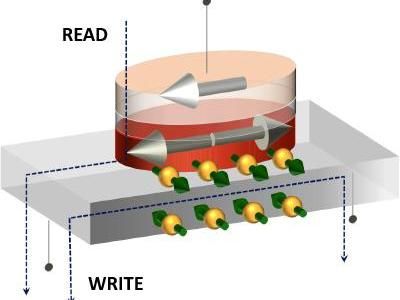Using magnetic permeability to store information
Scientists have made promising steps in developing a new magnetic memory technology, which is far less susceptible to corruption by magnetic fields or thermal exposure than conventional memory.
The findings, which report the use of magnetic permeability - how easily a magnetic field will magnetize a material - are published today, Friday 11th September, in the Journal of Physics D: Applied Physics.
These findings open up a new approach to a variety of applications from high-density radiation hard memory suitable for space travel to more secure ID cards.
In conventional magnetic memory, such as that in a computer, or the magnetic strip of a credit card, the memory is read by 'reading' the magnetization of the memory bit. As this magnetization is written using a magnetic field, it can also be erased by a magnetic field.
Magnetic permeability - an intrinsic property of 'soft' ferromagnets - is not changed by exposure to a magnetic field, and therefore information stored by programming changes in the magnetic permeability of each memory bit will not be erased by exposure to magnetic fields.
"It was a big step just coming up with the idea of using magnetic permeability to store information, and coming up with a practical way of getting the memory near the sensor so that it can be read" explains Dr Alan Edelstein, an author on the paper. "I was surprised and pleased that we could make this approach work."
The technique used thermal heating with a laser to crystallize amorphous regions of ferromagnets. As the crystalline areas have a lower permeability than the amorphous areas, information can be read from the memory by reading the changes in a probe magnetic field.
With credit cards, RF chips have offered a more stable form of memory, but these can be read by a passer-by using an RF reader. As the probe magnetic field needs to be in close vicinity to the memory, this technique offers a more secure technology.
One of the issues with traditional magnetic memory is that capacity is limited by the superparamagnetic limit - essentially the size of the particles used in the memory. By using the magnetic permeability an intrinsic property of the material, microstructure and composition of the material become the limiting factors.
"At present we have low density sized bits" continues Edelstein. "But we have the potential to get much higher since we are not limited by the superparamagnetic limit - there are difficult technological limitations to overcome first though."
The paper also reports that the memory is less prone to degradation when exposed to gamma radiation - something that is important for memory used for space travel, as the memory would have to feature less shielding, thus reducing its weight.
The researchers are now working on a technique to make the memory re-writable. "We've demonstrated the ability to rewrite bits for a read/write memory, and hope to publish the results soon." concludes Edelstein.
Original publication
Other news from the department science

Get the chemical industry in your inbox
By submitting this form you agree that LUMITOS AG will send you the newsletter(s) selected above by email. Your data will not be passed on to third parties. Your data will be stored and processed in accordance with our data protection regulations. LUMITOS may contact you by email for the purpose of advertising or market and opinion surveys. You can revoke your consent at any time without giving reasons to LUMITOS AG, Ernst-Augustin-Str. 2, 12489 Berlin, Germany or by e-mail at revoke@lumitos.com with effect for the future. In addition, each email contains a link to unsubscribe from the corresponding newsletter.




























































